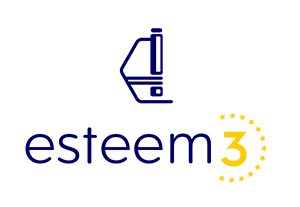Deliverable 5.3 - Report on quantitative chemical atomic resolution mapping (Unveiling the Future of Precise Atomic-Level Analysis)

The ability to identify the precise location and type of atoms and understand how they bond is crucial in modern material analysis. As it is the chemical compositions and atomic structural arrangements that ultimately drive the properties and functionalities of materials, we need reliable pathways to explore elemental occurrences quantitatively. This article summarizes the deliverable 5.3 which reviews these issues.
Dynamic Scattering
The first figure of ESTEEM3's report illuminates some of the fundamental phenomena that occur when a pencil-type STEM probe transmits a single crystal material along a low index zone-axis. This visualization demonstrates electron channeling, a process that is beneficial for atomic resolution imaging, producing enhanced signals with high contrast. However, for reliable quantitative analysis based on X-rays or EELS signal, we need to operate under kinematical conditions, which is often not applicable when atom counting is envisioned.
Quantitative Chemical Composition Analysis with EDXS and EELS
To understand the conversion path in EDXS and EELS from recorded intensities to concentrations, a few equations have been laid out in the report. They not only show the connections between the respective techniques but also reveal the potential for synergistic use of a simultaneous heavy and light element analysis. The project underlines that a simultaneous acquisition strategy provides the most information gain and flexibility for chemical analysis. However, it must be accompanied by efforts to understand and mitigate the influence of beam propagation.
Handling Dynamic Scattering Effects and Possible Solutions
Simulation-assisted studies have proven beneficial in cases of large compositional changes in the elemental distribution. A novel methodology developed in this project enables determining the concentration of two elements within equivalent atomic columns from EELS elemental maps. This opens up new opportunities for the analysis of a wide variety of multi-metallic nanocrystals.
Furthermore, the need to handle beam dose to the specimen, which could potentially lead to damage and mass loss, is critical in atomic resolution elemental analysis. Novel STEM strategies have been developed to reduce dose-accumulation effects. A combination of acquiring random sparse images and employing adapted post-processing techniques has emerged as an efficient way to reduce total electron dose and dose accumulation effects.
However, the most significant potential lies in improved beam management. Innovations to the microscope scan engines at the hardware level that yield more flexibility will alleviate the current limitations of STEM imaging. Technological advancements like beam precession have the potential to reduce the problems of enhanced or reduced inelastic intensities in spectroscopy.
Conclusion
The challenge of determining elemental compositions at the atomic scale accurately lies in overcoming the dynamical scattering of the electron beam. Image simulations estimating these effects for known structures can assist the corrections needed to convert false inelastic signal intensities. Incorporating other imaging modalities and connecting them with spectroscopies also shows promise for the analysis of certain material systems. Yet, the greatest prospects currently lie in improved beam management and the importance of high-quality thin specimen lamellae preparation. With the next generation of STEM microscopes around the corner, we can expect to see significant improvements in this specific application soon.
